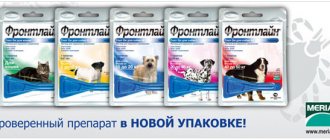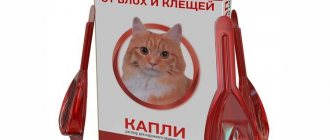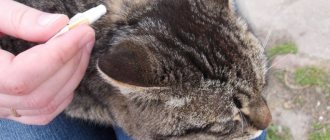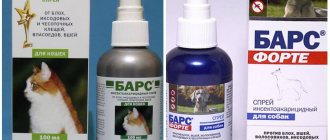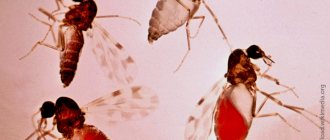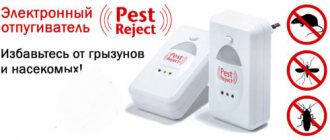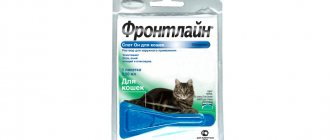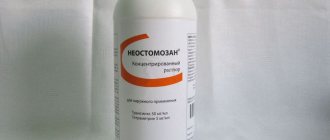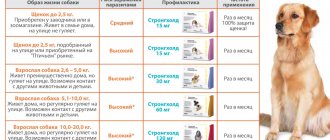Save article:
One of the common problems with cats is ectoparasites. Fleas, ticks, cheylitelas, otodexodes, lice eaters cause a lot of trouble for furry pets. In addition to the fact that these insects cause itching and dermatitis, they are often carriers of serious infectious diseases. Infection is facilitated by contact with stray animals. To protect your domestic cat from blood-sucking parasites, it is necessary to regularly use special flea products. Many of them have a wide spectrum of action. The drug Frontline is one of them.
Types of Frontline for cats
global $ads_google; //data-ad-slot=”2475549904″ $ads_google = empty($ads_google) ? false : true; ?> if ($ads_google == false) {?>
$ads_google = true; ?> } ?>
Frontline for cats contains the substance fipronil, which is poisonous to fleas and ticks. Organic compounds are used as additional components: butylhydroxyanisole, ethanol, butylhydroxytoluene, excipient. Fipronil accumulates in the animal's skin (hair follicles, sebaceous glands, epidermis) and, when bitten, enters the parasite's body. The poison causes paralysis of the insect and its death.
After processing the animal, at least 24 hours must pass. This time is necessary for the uniform distribution of fipronil over the skin. The drug does not enter the cat’s blood or digestive tract. A sufficient concentration of the active substance remains in the pet’s body for up to 45-60 days. After this, re-processing is necessary.
The manufacturer of the drug Frontline is the French pharmaceutical company Merial. The insectoacaricidal agent is available in different forms: in the form of drops, spray. The choice of a suitable variety is determined by the degree of infection, the susceptibility of the organism and the purpose of treatment (treatment, prevention).
Drops Combo
Frontline Combo in drop form contains, in addition to fipronil, another active substance S-methoprene. The amount of these compounds is approximately the same - 9.8% and 8.8%, respectively. Frontline drops are a colorless, transparent solution with a pungent odor. Standard packaging volume is 0.5 ml. But in pet stores you can sometimes find a 0.67 ml package; 1.34 ml; 2.68 ml and 4.02 ml.
Frontline Combo acts on all stages of parasite development: adults, larvae, eggs
Drops Spot It
In terms of its organoleptic properties, Frontline Spot is reminiscent of Combo. This product is also colorless, transparent and has a slight specific odor. The liquid is in a pipette. Apply it to the animal's skin in places inaccessible to licking. There are different packaging available for sale: 0.5 ml; 0.67 ml; 1.34 ml; 2.68 ml and 4.02 ml. There is only one active ingredient – fipronil, the share of which in the drug is 10%.
Spray
The aerosol form of the medicine is convenient for treating the entire surface of the animal against parasites. The bottles have different volumes: 100, 250 or 500 ml. With one press of the spray of the first dosage, 0.5 ml of the drug gets onto the fur. From a larger volume bottle, up to 1.5 ml of solution comes out with one press. These numbers are used to calculate the dose based on the weight of the pet. Frontline spray is convenient not only for treating a cat’s fur, but also its bedding and carpets.
Owner reviews
Bonnie-Blue: “Frontline drops were recommended to me by both the vets and a volunteer friend who helps homeless animals. I treated my cat with them for several years and was satisfied. But last year I also got a dachshund. The drops don't help her at all. Moreover, allergies popped up. I took the drug at the clinic, so counterfeits are excluded.”
CHOYU: “My two dogs spend the summer at the dacha, where there is a sea of ticks. I give them Spectra and no problems: insects only allow themselves to crawl on animals.”
Katushka: “We came out of town for the weekend. While combing, I discovered fleas on my Spitz dogs. The choice of medication has become a problem because... I had a recently whelped female with two-week-old kittens. I decided that it was better to use Frontline Spray. It smells unpleasant, but the fleas disappeared on the third day. And all the pets, including babies, underwent the procedure without any problems.”
Advantages and disadvantages of products
global $ads_google; //data-ad-slot=”2475549904″ $ads_google = empty($ads_google) ? false : true; ?> if ($ads_google == false) {?>
$ads_google = true; ?> } ?>
The history of the use of the pharmaceutical drug in veterinary practice allows us to place Frontline for cats on a par with other known products against fleas and ticks. The ratio of pros and cons determines the feasibility of its use. The advantages of the drug are:
- Highly effective against several types of ectoparasites.
- Wide range of effects (acts on different stages of development).
- Prolonged period of activity of fipronil.
- Harmlessness of active ingredients for the pet itself.
- Can be used for kittens and pregnant cats.
- Convenient application of the product to the fur or skin of an animal.
Frontline Spot On, Combo and Spray have their drawbacks. So, the liquid product must be dosed strictly, based on the cat’s weight. If the amount of the drug is insufficient, the effect is not achieved. Exceeding the optimal dose may have a negative effect on your pet's health.
When spraying Frontline spray, it may come into contact with the cat's mucous membranes. This causes local irritation and redness. If such a nuisance occurs, the cat should immediately rinse its eyes and nose with running water. The pet cannot be petted or bathed for two days. The use of a toxic liquid requires strict adherence to hygiene rules (washing hands after handling).
Frontline has a characteristic unpleasant odor that not all cats like
FAQ
The instructions answer most questions about the drug, but they still arise. There are important points.
At what age can Frontline be used for puppies?
Tablets and drops are recommended from two months, spray - from two days.
How long does Frontline last on a dog?
The effect of drops, tablets, sprays is one month. If you often bathe your pet, external preparations “work” for three weeks.
Are dogs allergic to the drug?
Yes, it happens (rarely). If symptoms occur, rinse the coat. Contact your veterinarian and have him prescribe antihistamines.
Indications for use
According to the instructions, Frontline for cats is used for preventive and therapeutic purposes. It helps get rid of many parasites and prevent infection by them. The use of drops and spray is justified for the following problems:
- Fleas;
- Ticks;
- lice eaters;
- Cheylitelas;
- Otodexodes;
- Lice.
For the treatment of otodectosis, only Frontline Spot On is acceptable.
How often can it be used
The active substance remains in the skin for several weeks. This determines the period of acaricidal and insecticidal action. Frontline protects against fleas for two months, and against ixodid ticks for one month. The frequency of use of Frontline may depend on the season. In the spring and summer, when tick activity peaks, the treatment is repeated monthly. In cold weather, it is enough to treat the animal once every seven to eight weeks.
Product line
The company presents a fairly wide range of products in various categories. Manufactured medications are classified by purpose, dosage and effect. As for flea products, the brand is represented by the following range of drugs:
Advertising:
- "Frontline Tri-Act";
- "Frontline NexGar" and "Nexander Spectrum";
- "Frontline Combo";
- "Frontline Spot On";
- Frontline Spray.
All these drugs effectively fight parasites and protect your pet from repeated infections.
Instructions for use Frontline
global $ads_google; //data-ad-slot=”2475549904″ $ads_google = empty($ads_google) ? false : true; ?> if ($ads_google == false) {?>
$ads_google = true; ?> } ?>
The technique of using the drug depends on its form. Frontline drops are applied directly to the skin, spreading the fur. The areas where the product is dripped are located on the withers, between the shoulder blades along the spine. Spot application over the entire body is not allowed. One adult cat requires one Frontline Spot on or Combo pipette with a volume of 0.5 ml. If the pet's weight is less than 1 kg, then the dosage is adequately reduced.
For ear scabies, Frontline Spot He is dripped into both ears, 4-6 drops. After this, the auricle is covered and gently massaged at the base with your hand so that the drug is evenly distributed over the skin. The spray is sprayed over the entire surface of the wool from a distance of 10-15 cm. Then lightly rubbed in. Treatment against fleas and ticks is carried out with gloves on and the window open. The aerosol bottle is shaken before use.
When spraying the spray, it is important to ensure that the drug does not get into your pet’s eyes, mouth, or nose.
Triple action insecticide
Regardless of the breed of the animal, it can become infected with fleas, ticks and various types of flying insects. To destroy these parasites, you can use Frontline Three - Act. The insecticide has a quickly effective effect, and re-infection after treatment practically does not occur.
It can be used as a medicine for the prevention of:
- anaplasmosis;
- ehrlichiosis;
- leishmaniasis.
This drug has passed all kinds of tests. It is harmless to your pet. The product is completely safe, suitable for puppies starting from the second month of life. It is also suitable for pregnant and lactating animals.
The insecticide is available in five different packages, depending on the weight of the pet.
How to use:
- the animal's skin must be clean and undamaged;
- remove the pipette from the blister;
- put two points, one between the shoulder blades, the second on the back of the head;
- Before applying the Frontline insecticide, we part the fur, only after that we drip drops (with regards to puppies, the application procedure is similar for them).
In order not to harm your pet, it is recommended to do everything according to the instructions included.
Contraindications
According to the instructions for use, Frontline for cats is a harmless drug if applied correctly. It has few contraindications. This is why anti-parasite drops and sprays are popular with many owners of fluffy cats. The main obstacle to the use of any form of Frontline (Spot On, Combo, spray) is individual intolerance. If your cat develops symptoms of allergies, irritation, or changes in behavior under the influence of the medication, you should show it to the veterinarian and change the drug.
It is recommended to use the drug with extreme caution for weakened or sick animals. There is another temporary contraindication – deworming. It is not advisable to combine two procedures in one day. At least 10 days must pass between them so that the body does not suffer from the single action of a large amount of toxic substances. This warning applies to any flea and tick product.
Is Frontline suitable for pregnant cats and kittens?
Fipronil and S-methoprene belong to the group of low-toxic substances. They do not penetrate the bloodstream, but accumulate only in the dermis. The drug does not have a teratogenic or mutagenic effect. Therefore, the product is allowed to be applied to the body of pregnant cats and kittens.
A very small kitten should be treated for fleas and ticks only if absolutely necessary. For example, if he was picked up on the street. If the cub is breastfed, then you should remember that traces of medicine from its fur can enter the body of the mother cat when licked. Therefore, it is worth assessing the feasibility of treating a baby with Frontline.
Analogs
Fipronil is a popular remedy for ixodid ticks. There are many analogues containing it:
- Palladium Ultra Protect (drops);
- Bravecto;
- KRKA Fiprist;
- Sentry FiproGuard Max (contains cyphenothrin);
- Dana-Ultra from Api-San;
- Vet Agro Fiprex spray;
- Centrovet Rexolin;
- Bars-Forte;
- Barrier-Super.
Permethrin is also popular for insect control. Here are analogues with its content:
- Canigard SpotOn;
- Vectra 3D;
- Neostomasin;
- Drontal plus;
- Prazicide;
- Sentry.
S-methoprene is contained in Fipren, Certifect, Rexolin, Profi Line drops, Palladium Pet Line.
Prices for Frontline for cats and kittens
The cost of the drug is determined by the shape and size of the container. Fluctuations in price in different regions of the country and in different pharmacies are insignificant. One 0.5 ml Frontline Spot On pipette costs about 400-500 rubles. The price of the flea and tick drug Frontline Combo varies approximately within the same limits.
Frontline spray costs an order of magnitude more than drops. The price for a bottle with a minimum volume (100 ml) ranges from 1000 to 1300 rubles. A medium-packed drug (250 ml) costs 1500-1800 rubles. The most expensive is a large bottle (500 ml). Its price reaches 2600 rubles.
Efficiency
Frontline drops for dogs
Frontline drops for dogs reviews are mostly positive. This confirms the effectiveness of the product, as well as safety for your pet.
I started using Frontline drops after an allergic reaction occurred to other means of similar action. My dog’s body accepted this drug well. We've been using it for two years now. 2 treatments are enough for the season.
Marina, Moscow
An effective drug. The treatment procedure takes 5 minutes, the effect lasts 3 months. I have been buying this for my dog for fleas for three years now. No allergic reaction was observed. Once it turned out that she licked it off the fur, a lot of saliva came out and that was all. A day later everything got better.
Angelina, St. Petersburg
How to distinguish from a fake
Since the drug Frontline is a popular remedy and is often recommended by veterinarians, fakes are sometimes found in pet pharmacies. To protect yourself from a useless purchase, it is worth knowing the distinctive features of the original. These include:
- A plastic container with drops is always packed in a sealed cardboard package;
- The Frontline logo is printed directly onto the dropper itself;
- The company name is printed on the packaging;
- The batch number and production date are duplicated on the applicator and cardboard base;
- Each copy is accompanied by a leaflet with detailed instructions for use;
- There are no additional holograms or stickers on the packaging;
- For Frontline spray and drops, the composition, concentration, and volume of the drug are indicated;
These external signs are classic. Merial periodically changes some design elements. The color of the packaging or the photo of the cat may change. Some blisters are marked “PCT”, which replaces the Soviet quality mark and means that the product meets the requirements of GOST certification.
Precautionary measures
As mentioned above, the medication is one of the drugs that is low-risk for the body of dogs.
Complies with GOST standard 12.1.007.76 However, when working with Frontline, as with any medicine, precautions should be taken:
Strictly observe the dosage of the drug. Do not use in conjunction with an anti-parasitic collar. Observe age restrictions on the use of the product. Use with caution on weakened and older dogs. Use with caution for pregnant and lactating individuals. If possible, during these periods, avoid any chemical exposure without special indications. Be sure to check with your veterinarian about possible interactions between fipronil and other medications. Before use, you should make sure that the dog does not have an individual intolerance to the components of Frontline.
special instructions
If there is increased individual sensitivity to the components of the drug and signs of allergic reactions appear, the treatment is stopped, the drug is washed off with water, and antihistamines are given orally. + When working with Frontline Combo, you should follow the rules of personal hygiene and safety precautions provided for working with medicinal products for animals. While working with the medicine, you are not allowed to drink, smoke, or eat. If Frontline Combo accidentally gets on the skin or mucous membranes, it should be washed off with a stream of water. After finishing work, wash your hands with warm water and soap. Empty drug pipettes must not be used for household purposes; they must be disposed of with household waste.
Release form:
Interaction with other drugs
The drug developers point out that the simultaneous use of Frontline products with other insectoacaricides is inadmissible. This can lead to mutual reinforcement of toxicity and poisoning of the pet.
Interaction of the drug with antibiotics and other strong drugs is also undesirable. If the time to treat your cat for parasites has come when the animal is being treated with some kind of medication, then you should consult a veterinarian. He will be able to tell you exactly whether Frontline can be combined with the specific drug being used.
Recommendations
There is no need to bathe the animal 2 days before and 2 days after treatment. Until the fur is completely dry, you need to make sure that the animal does not lick the drug. Also, do not allow it near heating devices or open fire. Young children should be excluded from contact with the animal for 24 hours. During this time you cannot pet him. To avoid re-infestation and prevent fleas from breeding, the bedding should be replaced. In addition, the following rules must be observed:
- after applying the spray, you should wash your hands with soap;
- when applying the product, do not eat, drink or smoke;
- the drug should be stored out of the reach of children.
High effectiveness of the drug is achieved by following the recommended regimen of its use. When using the product, you should not use other insectoacaricidal drugs.
What danger do ticks and fleas pose to dogs?
Dog fleas are carriers of deadly diseases such as salmonellosis, brucellosis, and plague. Parasites can infect pets with worms. At the same time, fleas easily move onto humans, carrying with them such dangerous diseases as anthrax and encephalitis. The movement of fleas through the animal's fur causes itching, which can lead to skin problems and the appearance of allergic dermatitis and anemia.
Ticks are no less dangerous blood-sucking parasites, which are primarily carriers of piroplasmosis, which has fatal consequences. When infected, fever, anemia, and dark-colored urine appear. The dog refuses to eat and behaves lethargically. By identifying symptoms early and seeking veterinary help, your pet can be saved.
Therefore, when insects appear on an animal, it is necessary to urgently begin to combat the parasites.
